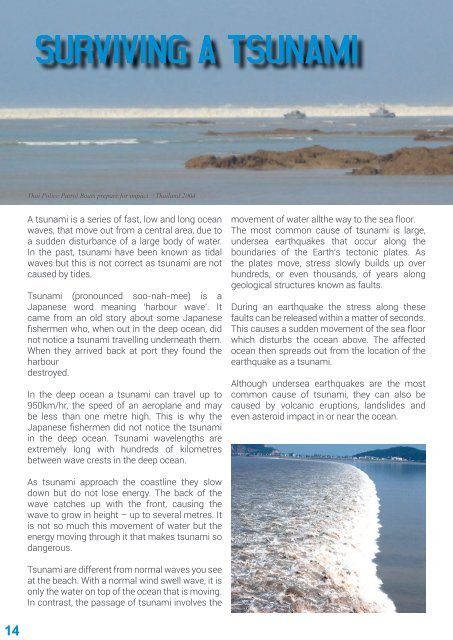Emergency Dispatch Vol 4 2014
You also want an ePaper? Increase the reach of your titles
YUMPU automatically turns print PDFs into web optimized ePapers that Google loves.
14<br />
SURVIVING A TSUNAMI<br />
Thai Police Patrol Boats prepare for impact. / Thailand 2004<br />
A tsunami is a series of fast, low and long ocean<br />
waves, that move out from a central area, due to<br />
a sudden disturbance of a large body of water.<br />
In the past, tsunami have been known as tidal<br />
waves but this is not correct as tsunami are not<br />
caused by tides.<br />
Tsunami (pronounced soo-nah-mee) is a<br />
Japanese word meaning ‘harbour wave’. It<br />
came from an old story about some Japanese<br />
fishermen who, when out in the deep ocean, did<br />
not notice a tsunami travelling underneath them.<br />
When they arrived back at port they found the<br />
harbour<br />
destroyed.<br />
In the deep ocean a tsunami can travel up to<br />
950km/hr, the speed of an aeroplane and may<br />
be less than one metre high. This is why the<br />
Japanese fishermen did not notice the tsunami<br />
in the deep ocean. Tsunami wavelengths are<br />
extremely long with hundreds of kilometres<br />
between wave crests in the deep ocean.<br />
movement of water allthe way to the sea floor.<br />
The most common cause of tsunami is large,<br />
undersea earthquakes that occur along the<br />
boundaries of the Earth’s tectonic plates. As<br />
the plates move, stress slowly builds up over<br />
hundreds, or even thousands, of years along<br />
geological structures known as faults.<br />
During an earthquake the stress along these<br />
faults can be released within a matter of seconds.<br />
This causes a sudden movement of the sea floor<br />
which disturbs the ocean above. The affected<br />
ocean then spreads out from the location of the<br />
earthquake as a tsunami.<br />
Although undersea earthquakes are the most<br />
common cause of tsunami, they can also be<br />
caused by volcanic eruptions, landslides and<br />
even asteroid impact in or near the ocean.<br />
As tsunami approach the coastline they slow<br />
down but do not lose energy. The back of the<br />
wave catches up with the front, causing the<br />
wave to grow in height – up to several metres. It<br />
is not so much this movement of water but the<br />
energy moving through it that makes tsunami so<br />
dangerous.<br />
Tsunami are different from normal waves you see<br />
at the beach. With a normal wind swell wave, it is<br />
only the water on top of the ocean that is moving.<br />
In contrast, the passage of tsunami involves the





